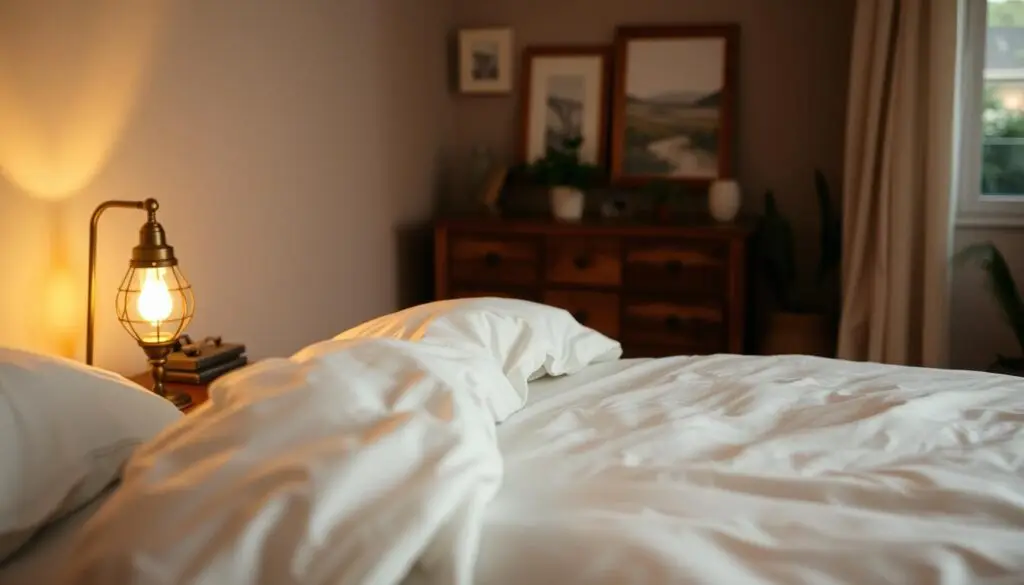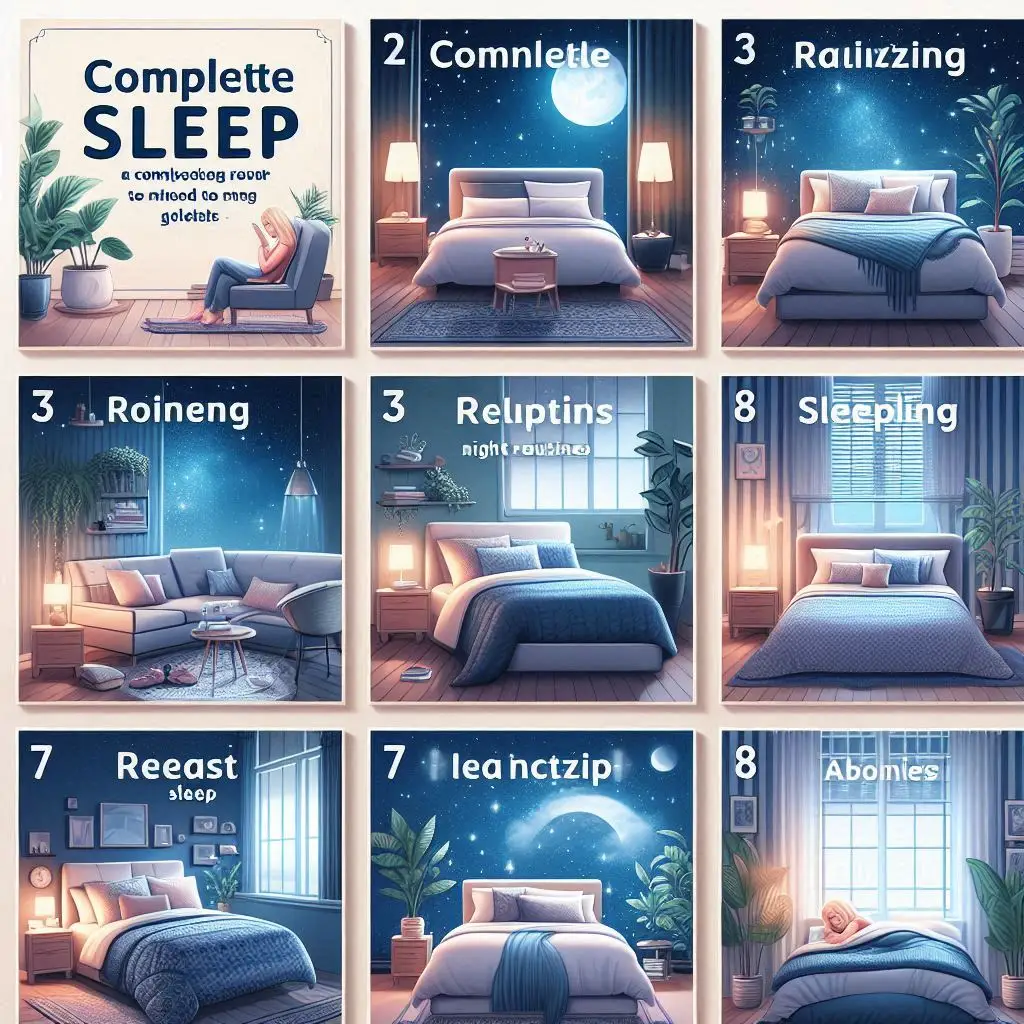Sleep Guide: Discover 7 essential steps for better sleep, from bedtime routines to sleep hacks for a restful and healthy night. Follow our comprehensive sleep guide to maximize your rest.
Table of Contents
Your Complete Sleep Guide: What You Need to Know
In this ultimate sleep guide, we’ll discuss sleep’s importance and how to improve it.
This sleep guide offers valuable insights into the essential nature of sleep, emphasizing how quality sleep contributes to overall health and wellness.
Sleep is key for our health and well-being, as the National Sleep Foundation says. Dr. Matthew Walker, a sleep expert, notes, “Sleep is the single most effective thing we can do to reset our brain and body health each day.” Knowing about sleep and its stages is vital for a healthy life. This article will explore sleep’s basics, stages, and why it’s important every day.
Understanding your sleep is crucial, and this guide will help you navigate all the information you need.
Our sleep guide will empower you with the knowledge to combat sleep deprivation and improve your sleep quality effectively.
This sleep guide will illustrate the connection between sleep and mental performance, showcasing its impact on daily activities.
In this sleep guide, we will highlight practical tips for enhancing your sleep environment and nighttime habits.

This guide will cover sleep’s biology, sleep-wake mechanisms, and sleep stages’ science. We’ll also talk about sleep disorders, sleep deprivation symptoms, and how to create the best sleep environment. Whether you’re having trouble sleeping or want to improve it, this guide will help you understand and manage your sleep.
Introduction to Sleep
Following this sleep guide will also educate you on sleep disorders and how to identify their symptoms.
Sleep is crucial for our physical and mental health. Learning about sleep, its stages, and its importance can help us sleep better and feel better overall.
Key Takeaways
- Understanding sleep and its stages is crucial for maintaining a healthy lifestyle
- Sleep is essential for our physical and mental health
- Learning about the importance of sleep can help improve sleep quality
- Sleep stages, including REM and non-REM sleep, play a vital role in our overall health
- Creating the optimal sleep environment can help improve sleep quality
- Understanding the causes of sleep disorders and symptoms of sleep deprivation is vital for maintaining good sleep health
Understanding the Fundamentals of Sleep
Sleep is key to our health and happiness. Our body goes through sleep stages like light sleep, deep sleep, and REM sleep. These stages help us recover physically and mentally and keep our sleep cycle in check.
This sleep guide will delve into the biology of sleep, providing a comprehensive overview of why understanding sleep is essential.
As you read through this sleep guide, you will gain insights into how to develop a better sleep routine.
A sleep cycle lasts 90-120 minutes. It has three non-REM stages and one REM stage. Knowing about these stages helps us fix sleep problems and keep a healthy sleep routine.
By following the strategies outlined in this sleep guide, you can significantly improve your sleep quality over time.
This section of the sleep guide focuses on the science behind sleep stages and their meaning for your health.
Our lifestyle, environment, and health affect our sleep. Natural light, exercise, and a healthy diet help our sleep cycle. But stress, caffeine, and screens can mess with our sleep stages and make it hard to sleep well.
Learning about sleep and its health benefits helps us improve our sleep cycle and well-being. We can make our sleep better by creating a comfortable sleep space, sticking to a sleep schedule, and avoiding bedtime activities that excite us.
The Science of Sleep Stages
Understanding sleep stages is key to grasping sleep’s complexity. There are two main sleep types: REM and non-REM sleep. REM sleep is known for rapid eye movements, high brain activity, and vivid dreams. In contrast, non-REM sleep has slower brain waves, lower body temperature, and little eye movement.
A sleep cycle includes three non-REM sleep stages and one REM sleep stage. Each stage is unique, with its own brain wave patterns, eye movements, and muscle tone. The first non-REM sleep stage is the lightest, making it simple to wake up. The second stage has slower brain waves. The third stage, also known as slow-wave sleep, is the deepest.
The main features of sleep stages are:
- REM sleep: rapid eye movements, increased brain activity, and vivid dreams
- Non-REM sleep: slower brain waves, reduced body temperature, and minimal eye movement
- Stage 1 non-REM sleep: lightest stage, easy to wake up
- Stage 2 non-REM sleep: slower brain waves
- Stage 3 non-REM sleep: deepest stage, slow-wave sleep
Knowing about sleep stages and their traits is vital for solving sleep problems. It helps improve overall health and well-being. By focusing on REM sleep and non-REM sleep, people can enhance their sleep quality. This leads to waking up feeling refreshed and ready to go.
This sleep guide will reveal the interplay between sleep cycles and overall health.
Exploring REM Sleep and Dreams
REM sleep is a key part of our sleep cycles. It’s marked by rapid eye movement, high brain activity, and vivid dreams. During this stage, our brain sorts through memories and stores them for the long term.
It’s vital for learning and memory.
Dreams happen during REM sleep. They might help us deal with emotions in a safe way. Dreams also give us a peek into our subconscious thoughts and desires.
Dreams have many roles in sleep cycles. They might help us remember things or solve problems. Dreams are a big part of REM sleep. Understanding them can give us insights into our sleep and well-being.
- Brain activity: REM sleep is characterized by increased brain activity, similar to wakefulness, while non-REM sleep is marked by slower brain waves.
- Eye movement: REM sleep is associated with rapid eye movement, while non-REM sleep is characterized by slow eye movement or no eye movement at all.
- Muscle tone: REM sleep is marked by relaxed muscle tone, while non-REM sleep is associated with increased muscle tone.
Knowing the differences between REM and non-REM sleep helps us see how complex sleep cycles are. REM sleep and dreams are crucial for our health and well-being.
Your Natural Sleep-Wake Cycle
Understanding your natural sleep-wake cycle is key to better sleep. This cycle is controlled by circadian rhythms, which follow a 24-hour cycle. Light and darkness influence these rhythms, which in turn affect the timing of your sleep. A regular sleep cycle is vital for your health.
Many things can change your sleep schedule. For example, late work hours or traveling can mess with your circadian rhythms. Also, screens before bed can lower melatonin, a hormone that helps you sleep.

To get better sleep, set a regular sleep schedule and make your sleep area suitable for rest. Avoid exciting activities before bed, keep your sleep area dark and quiet, and don’t have caffeine or nicotine near bedtime. By understanding and working with your sleep-wake cycle, you can sleep better and wake up feeling good.
Here are some tips for better sleep timing:
- Establish a consistent sleep schedule
- Make your sleep area sleep-friendly
- Avoid exciting activities before bed
- Exercise regularly, but not before bed
Common Causes of Sleep Disorders
Sleep disorders, like insomnia and sleep apnea, can really hurt our health and happiness. Understanding the underlying causes of these disorders is crucial in combating sleep deprivation. Things like bad sleep habits and poor sleep spots can lead to these issues.
Genetics and our surroundings also matter. If your family has sleep problems, you might too. Also, too much noise, light, or cold can mess up our sleep patterns.
- Irregular sleep schedules
- Poor sleep environments
- Genetics
- Environmental factors, such as noise and light exposure
Fixing the root causes of sleep disorders is vital for better sleep and health. Knowing what leads to these problems helps us prevent and treat them. This way, we can enjoy better sleep and live healthier lives.
Recognizing Sleep Deprivation Symptoms
Sleep deprivation can really affect our daily lives. It can change our mood, how well we think, and our overall health. It’s key to know the signs of sleep deprivation to stop or manage sleep problems.
When we don’t get enough sleep, we feel tired, less productive, and more likely to make mistakes. Some signs of sleep deprivation include dark circles under the eyes, pale skin, and changes in weight. We might also feel irritable, anxious, or depressed.
Long-term sleep deprivation can lead to serious sleep disorders. These disorders can significantly harm our health and quality of life.
Physical Signs of Poor Sleep
- Dark circles under the eyes
- Pale skin
- Weight gain or loss
- Headaches and migraines
Mental and Emotional Indicators
- Irritability and mood swings
- Anxiety and depression
- Decreased concentration and focus
- Memory lapses and difficulty learning new information

It’s very important to tackle sleep deprivation and disorders to avoid long-term health issues. By spotting the signs of sleep deprivation and getting help, we can start improving our sleep and health.
Modern Sleep Diagnosis Methods
Technology has made sleep diagnosis more accurate. A sleep study is key to understanding sleep habits. You can conduct it in a lab or use devices at home.
There are many sleep studies, like polysomnography and actigraphy. Sleep monitoring devices track sleep patterns and quality. They are easy to use at home.
Knowing when to get help for sleep issues is important. If you have trouble sleeping or feel worn out during the day, see a doctor. They might suggest sleep study or monitoring.
- Keep a sleep diary
- Avoid caffeine and electronics before bed
- Make your sleep area relaxing
Learning about sleep diagnosis and preparing for a study can help improve your sleep. It’s all about taking control of your sleep health.
Creating the Optimal Sleep Environment
To get better sleep quality, focus on your sleep environment. Make sure your bedroom is dark, quiet, and cool. This helps you sleep well.
Here are some tips for a better sleep environment:
- Invest in blackout curtains or blinds to block out light
- Use earplugs or a white noise machine to reduce noise
- Keep your bedroom at a cool, comfortable temperature
Also, keep a regular sleep schedule and a calming bedtime routine. This can be reading, a warm bath, or gentle stretches.
By improving your sleep environment and sleep hygiene, you’re on the right path. You’ll wake up feeling refreshed and ready to go.
Conclusion: Taking Control of Your Sleep Health
As we wrap up our sleep guide, the main point is clear: controlling your sleep is key to your health. You now know about sleep stages, circadian rhythms, and sleep disorders. This knowledge helps you improve your sleep quality.
Putting sleep first is crucial for your wellness. Stick to a sleep schedule, make your sleep space comfy, and find ways to handle sleep issues. Remember, good sleep is an investment in your health now and in the future.
With the tips from this guide, you can manage your sleep better. Quality sleep can change your life for the better. It’s time to unlock your full potential and live your best life.
FAQ
What are the different stages of sleep?
Sleep has four main stages. The first is NREM stage 1, where you start to relax. Then comes NREM stage 2, where your heart rate slows down. NREM stage 3 is the deepest sleep, where it’s hard to wake up. Finally, there’s REM sleep, where dreams happen and your brain is active.
What is the importance of REM sleep?
REM sleep is key for your brain. It helps with memory, learning, and emotions. Your brain is very active during this stage, leading to vivid dreams and less muscle tone.
What are the common causes of sleep disorders?
Sleep disorders can come from many places. Stress, anxiety, and depression are big ones. Medical issues like sleep apnea also play a part. Plus, lifestyle choices like bad sleep habits and too much screen time can affect sleep.
How can I recognize the symptoms of sleep deprivation?
Signs of not getting enough sleep include feeling awful during the day. You might find it challenging to focus or feel moody. You could also get headaches or gain weight.
What are the modern methods for diagnosing sleep disorders?
Today, we have many ways to figure out sleep problems. In-lab sleep studies and home devices can track your sleep. Talking to sleep experts is also important. These steps help find the cause and create a plan to fix it.
How can I create an optimal sleep environment?
For the best sleep, keep your room cool and quiet. Try to sleep at the same time every night. Also, have a calming bedtime routine. These steps can improve your sleep quality and length.
This sleep guide emphasizes the importance of creating a conducive sleep environment for better rest.
This sleep guide serves as your roadmap to optimal health through improved sleep practices.
To truly enhance your life, embrace the guidance provided in this sleep guide for a restful night.
This sleep guide will empower you to reclaim control over your sleep and, in turn, your health.
Utilize the insights from this sleep guide to tackle common sleep challenges effectively.
This sleep guide also addresses the misconceptions around sleep to clarify your understanding.
By following the latest findings in this sleep guide, you can elevate your knowledge and practice regarding sleep.
This sleep guide provides a comprehensive overview to help you optimize your REM sleep and overall rest.
Through this sleep guide, you’ll recognize how lifestyle changes can impact your sleep quality.
Share this content:

[…] Jaw-Dropping Sleep Guide: Revitalize Your Health with This 7-Step Plan […]